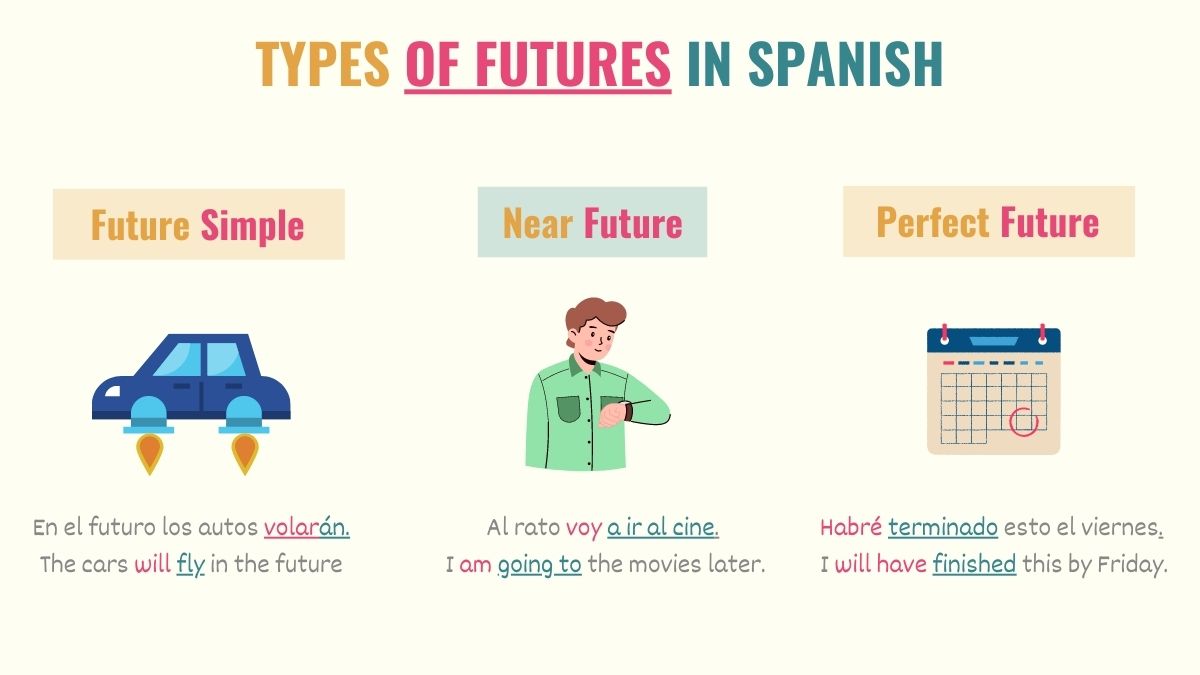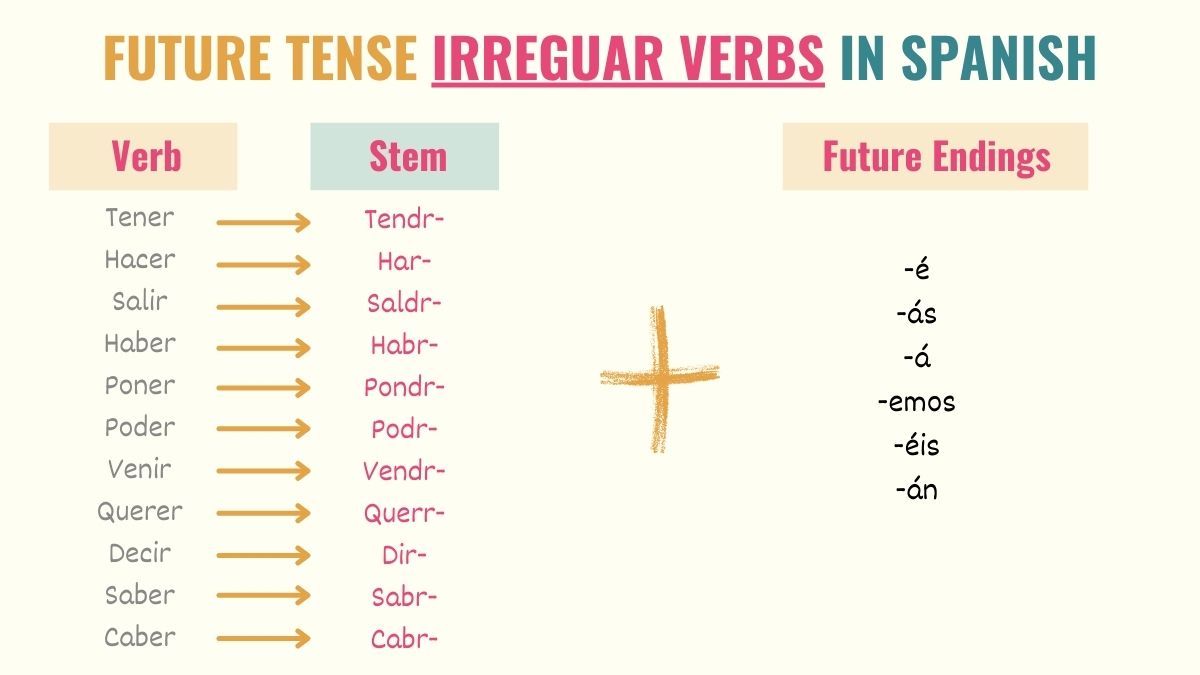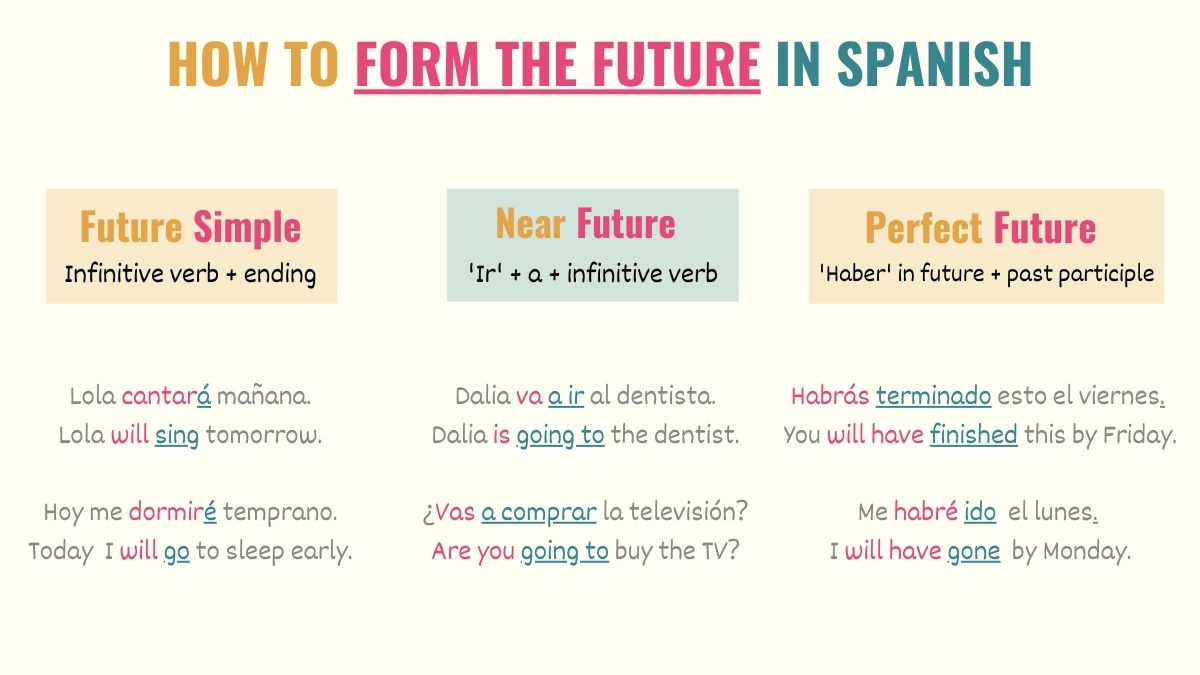The Spanish future tense is one of the most commonly used tenses. After all, without it, we wouldn’t be able to talk about our upcoming plans or activities. Since this is a crucial topic for anyone learning Spanish, you’ll find everything you need to know about this tense in this guide.
The points that we will cover are:
- Future Tense in Spanish: Uses & Definitions
- 3 Types of Future Tenses
- How to Conjugate the Future Tense in Spanish
- Difference Between Future & Conditional
- Key Points
If you still haven’t learned the future tense in Spanish, you’ll know when to use this tense and how to conjugate it by the end of this article.
What is The Future Tense in Spanish?
As its name suggests, the Spanish future is a tense that allows you to indicate that a certain action will take place at some point in the future. For example:
La semana que viene iremos a Londres.
Next week, we will go to London.
Vamos ahorita, al rato estaré ocupada.
Let’s go now; I will be busy later.
La fiesta de graduación será en un par de días.
The graduation party will be in a few days.
Like other Spanish tenses, you can use time markers (such as ‘al rato’, ‘la semana que viene’, etc.) to specify the moment the action will take place. If you’re unsure of what future time expressions you can use, here are some examples:
| Spanish | English |
|---|---|
| Mañana | Tomorrow |
| Al rato/Más tarde | Later |
| Pasado mañana | The day after tomorrow |
| El mes/año que viene | Next month/year |
| La semana que viene | Next week |
| El próximo sábado* | Next saturday |
| El próximo año | Next year |
| En un año/mes/semana** | In one year/month/week |
| En un par de años/meses/semanas/días | In a few years/months/weeks/days |
* You can replace the word sábado with another day of the week.
**You can replace un for another number.
El próximo jueves iré al aeropuerto.
I will go to the airport next Thursday.
La nueva temporada saldrá en un par de semanas.
The new season will come out in a few weeks.
Learning Spanish?
Join the Tell Me In Spanish community and get a copy of my step-by-step Spanish Learner’s Roadmaps and tricky synonyms & vocab cheat sheets.
How to use the future tense in Spanish?
We’ve already established the primary use of the future tense in Spanish. However, this tense has other key applications that you should consider. To summarize, the uses of the Spanish future tense are:
- Talk about actions, events and activities that will occur in the future.
- Make predictions and hypotheses about the future.
- Express conjectures and hypotheses about the present.
- Express the potential outcome of a conditional statement.
Check these examples below:
Use #1: Action, Event or Activity that will occur in the Future
[Verb in future tense] + [complement]
Terminaré la carrera el año que viene.
I will finish my major next year.
La escuela cerrará dos meses.
The school will close for two months.
Mañana vendrán tus tíos de visita.
Your aunt and uncle will come to visit tomorrow.
Use #2: Making a prediction or hypothesis about the future.
(Phrase to express supposition) + [verb in future tense] + [complement]
¡Ponte un suéter! Te vas a enfermar.
Put on a sweater! You are going to get sick.
Seguramente, cancelarán el partido.
They will probably call off the game.
Creo que Bill no tendrá tiempo mañana.
I think Bill will not have time tomorrow.
Use #3: Expressing a conjecture or hypothesis about the present.
(Phrase to express supposition) + [verb in future tense] + [complement]
¿Sabes dónde estará Pepe?
Do you know where Pepe might be?
Clara no ha llegado, ¿seguirá enferma?
Clara hasn’t arrived. Would she still be sick?
Leslie no tardará en llegar. Tiene una cita.
Leslie will be here soon. She has an appointment.
Use #4: Describe the potential outcome of a conditional statement.
[Condition] + [verb in the future tense]
Si llegas tarde, perderás el avión.
If you’re late, you will lose the plane.
Si encuentro los ingredientes, haré lasaña.
If I find the ingredients, I will make lasagna.
Take Note: When expressing predictions in the present, we refer to the potential actions or activities that a person may be doing in the present.
Types of Future Tenses in Spanish
In Spanish, there are three types of future:
- Simple future
- Near or immediate future
- Perfect future

The simple and near future can be used with the applications we mentioned earlier. However, the near future is an informal or casual version of the simple future.
As its name suggests, the near or immediate future is also used to talk about actions that will occur in the near future (within seconds, minutes, hours, or a few days). Finally, the near future is formed with different elements (more on this later).
Simple Future
El año que entra adoptaré un perro.
Next year, I will adopt a dog.
Near Future
Hoy voy a llevar a mi perro al veterinario.
Today, I am going to take my dog to the vet.
Take Note: From a grammatical point of view, the near future is slightly more informal than the simple future. However, Spanish speakers use these tenses interchangeably. In fact, the near future is more popular in daily conversations.
Perfect Future
The perfect future tense in Spanish is not nearly as common as the other types of future. However, it would be best if you had a general idea of how this tense works. The Spanish perfect future is a compound tense, meaning that you’ll need more than one verb to create it.
We use this tense to express that an action will be completed before a specific point in the future. Check these examples:
El lunes habré terminado mi proyecto.
I will have finished my project by Monday.
Cuando llegues, ya habré preparado la cena.
When you arrive, I will have already prepared dinner.
As you can see, my time references are ‘el lunes’ and ‘cuando llegues’, which means that I finished my actions before those points in time.
How to Conjugate to the Future Tense in Spanish?
To conjugate a regular verb to the Spanish simple future tense, you must add the future endings to the verb in its infinitive form. On the other hand, irregular verbs are conjugated by adding the same future endings to an irregular stem.
Conjugating verbs in future simple
The Spanish future is probably the easiest tense to conjugate since you only have to add the proper endings to your verb. These are the endings that you need to create the future tense in Spanish:
| Subject | Ending | English |
|---|---|---|
| Yo | -é | I will |
| Tú | -ás | You will |
| Él/Ella/Usted | -á | He/She/It will |
| Nosotros | -emos | We will |
| Vosotros | -éis | You will |
| Ustedes/Ellos | -án | You will |
Mañana iré al doctor.
I will go to the doctor tomorrow.
¡Vamos! Te divertirás muchísimo.
Let’s go! You will have a lot of fun.
En unos años, Collin será el mejor abogado.
In a few years, Collin will be the best lawyer.
The future tense in Spanish has eleven irregular verbs. These are stem-changing verbs, and, to conjugate them, you’ll simply add the previous endings to the stem. Keep in mind that other verbs that use the following verbs as suffixes will also be irregular (for example, deshacer, mantener, componer, etc).

No sé qué haré mañana.
I don’t know what I will do tomorrow.
Celia saldrá temprano de la oficina.
Celia will leave the office early.
La oferta se mantendrá por tiempo limitado.
The offer will last for a limited time.
Take Note: To conjugate a reflexive verb in the Spanish future tense, you have to make sure to place the proper reflexive pronoun in front of the conjugated verb.
Me pondré este vestido en tu boda.
I will wear this dress on your wedding day.
Forming the near future in Spanish
If instead you prefer to use the near future in Spanish, you’ll need to follow the formula below to form this tense:
[‘Ir’ conjugated in present tense] + a + [infinitive verb] + [complement]
Lenny y Mike van a trabajar el sábado.
Lenny and Mike are going to work on Saturday.
Al rato, voy a ir a la tienda, ¿quieres algo?
I am going to go to the store, do you want something?
¿Qué vamos a comer en Navidad?
What are we going to eat for Christmas?
Take Note: If the infinitive verb you use turns out to be a reflexive verb, you may wonder what to do with the reflexive pronoun. In this case, the pronoun can be attached to the infinitive verb or can be placed before the verb ‘ir’.
¿A qué hora te vas a bañar?
What time are you going to shower?
Creo que vas a bañarte con agua fría.
I think you are going to shower with cold water.
Conjugating the perfect future in Spanish
As established before, the perfect future is a compound tense. In simple words, this means that you need two verbs to form this tense: an auxiliary verb (haber) and a Spanish past participle. This is how you do it:
[‘Haber’ in future tense] + [verb in past participle]
El próximo año habré visitado 10 países.
I will have visited 10 countries by next year.
A las 8, habremos llegado a Perú.
We will have arrived in Peru by 8.
¿Ya habrán terminado de pintar su casa?
Do you think they will have finished painting their house?
Take Note: When it comes to the perfect future (or any compound tense for that matter), there is only one way to conjugate reflexive verbs in Spanish. In this case, the pronoun must always be placed before the auxiliary verb (‘haber’).
Cuando llegues, yo ya me habré ido.
When you arrive, I will have left.

Future vs. Conditional in Spanish
Since the future tense in Spanish can be used to express hypotheses and predictions, many people confuse this tense with the Spanish conditional. However, both tenses have different purposes.
When expressing predictions or hypotheses with the Spanish future tense, we’re referring to events that will likely happen in the future or activities that a person is potentially doing in the present.
The conditional tense, on the other hand, indicates that our prediction or hypothesis may come true if a specific condition is met. Sentences in the future tense make sense on their own. However, a conditional sentence is formed with two elements: the circumstance to be completed and the potential result.
Sentence in the future tense
Con este tráfico, Sofía llegará tarde al trabajo.
With this traffic, Sofia will be late for work.
Sentence in the conditional tense
Si el tráfico no mejora, Sofía llegará tarde.
If the traffic doesn’t improve, Sofia will be late.
Take Note: The future and conditional tenses are also distinguished from each other because of their endings. Remember that even though these tenses might work together, they are different.
Key Points About the Future Tense in Spanish
As you have learned, the future tense is crucial for your communication in Spanish. We covered a lot of ground in this article. So, here are some key points about the future tense in Spanish:
- There are three types of future tenses in Spanish: the simple future, the near (or immediate) future, and the perfect future.
- The simple future is used to:
- Talk about actions and events that will happen at a certain point in the future.
- Express predictions and hypotheses in the future.
- Express suppositions or predictions about what a person may be doing in the present.
- Share the potential result of a conditional statement.
- The simple future is formed by adding the future endings to the infinitive verb.
- There are 11 stem-changing, irregular verbs in the future tense in Spanish.
- The Spanish immediate future is a casual version of the simple future. It’s frequently used to talk about events that will happen near in the future.
- The near future is formed with the structure ir (in present tense) + a + infinitive verb.
- The perfect future in Spanish expresses that an action will be finished before a certain point in the future.
- Spanish perfect future is formed with the structure haber (in future tense) + past participle verb.



